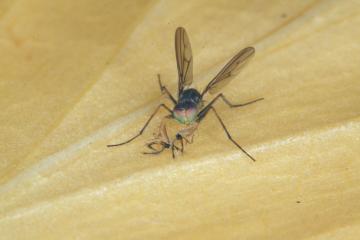Species Account for Campsicnemus magius
Campsicnemus magius (Loew, 1845)
Fancy-legged fly
Diptera: other groups: Dolichopodidae

Reproduction for study and non-profit use permitted, all other rights reserved.
Taxonomic group: flies (other) (Diptera: other groups) - County data
View time series maps for Campsicnemus magius
member log-on for taxon report
Status: NR;Section 41 Priority Species;VU
Images
upload a new image
Essex Red Data List comment
Recorded from 4 out of 57x10km.sq. records in county
Species text
Campsicnemus magius is a small dolichopodid fly in which the front legs of the male are strongly ornamented with processes and bristles which give the appearance of additional legs. It is given Near Threatened status in a recently published national status review (Falk & Crossley, 2005) and is also a new UKBAP species. Most records are from the Thames Estuary. The fly occurs on bare mud in coastal levels and upper saltmarsh where there is an intermediate level of salinity and does not normally occur on the tidal parts of a saltmarsh. The larval biology is unknown, but it is probably a semi-aquatic predator in mud. Adults are found skimming across areas of gently shelving bare mud. References
Habitats
Recorded management for locations with Campsicnemus magius
Recorded substrate and hydrology for locations with Campsicnemus magius
Why not join the Club, register and add a new species page
Interpretation of distribution maps



















